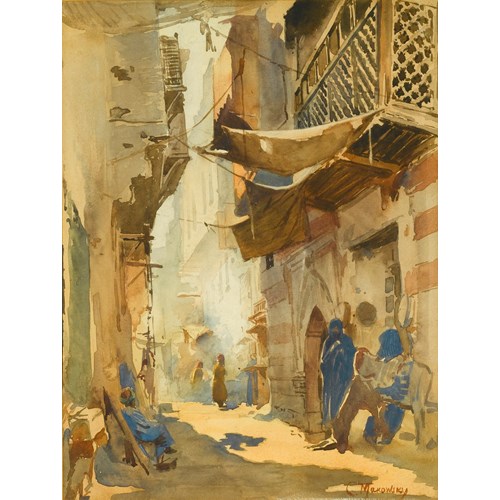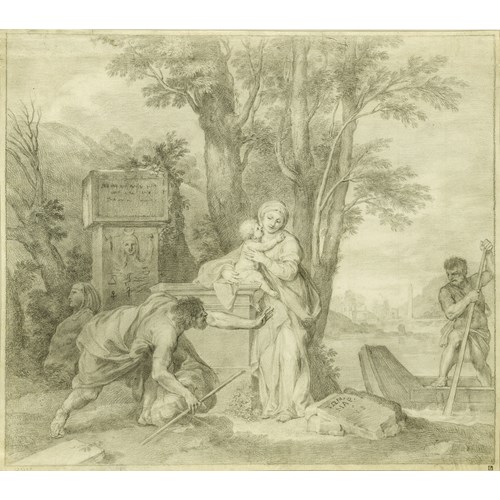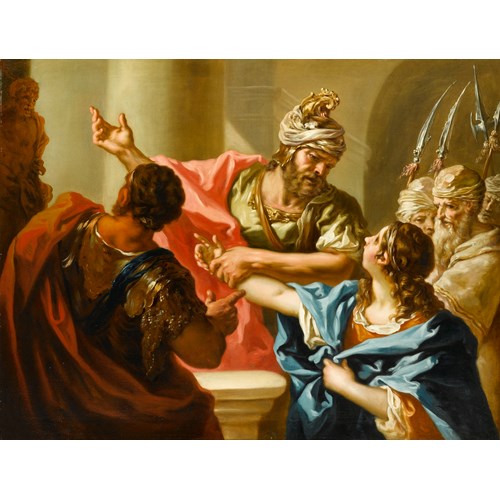Marketplace
"A Classical Landscape with a Family Resting by the Ruins of a Fountain, a Man with a Pack-Donkey Passing by" & "A Classical Landscape with a Family Resting by the Ruins, a Boy Struggling with an Obstinate Pack Mule"
Franz de Paula Ferg
"A Classical Landscape with a Family Resting by the Ruins of a Fountain, a Man with a Pack-Donkey Passing by" & "A Classical Landscape with a Family Resting by the Ruins, a Boy Struggling with an Obstinate Pack Mule"
Epoque 1600-1750, 18th century
Origine Austria, England
Medium Oil on copper
Dimension 17.5 x 21.6 cm (6⁷/₈ x 8¹/₂ inches)
With this pair of paintings Franz de Paula Ferg presents us with two delightful figurative mountainous landscapes set amongst classical ruins. In A Classical Landscape with a Family Resting by the Ruins of a Fountain, a Man with a Pack-Donkey Passing by a mother, father and child rest on a rocky mound. The child, open-mouthed, excitedly grasps out towards the donkey. All the adult figures, turned towards the toddler, delight in his reaction, the two female figures looking on with considerable affection. The family have stopped next to a fountain decorated with classical heads of satyrs or fauns, and the foliage that grows on the top of the fountain reinforces the impression of age and antiquity. The viewer’s eye falls back to the gentle, mountainous landscape beyond, through which we imagine the group have travelled.
The accompanying work, A Classical Landscape with a Family Resting by the Ruins, a Boy Struggling with an Obstinate Pack Mule is set in a similar Arcadian landscape. A classical ruin again provides a backdrop under which a family rest, the head of a faun appearing once more, this time carved into the stone under the right-hand scroll. This scene is however animated by the vigorous misbehaviour of the pack mule, which a young boy struggles to control. Both arid landscapes are lit with a soft gentle light and the rich colours of the figures’ clothes brighten the scenes. The two paintings are clearly a pair, unified by size, setting, subject matter and palette.
Ferg painted many such pairs of pastoral scenes. The Southampton City Art Gallery’s two Landscape with Figures are both set in a similar dry but idealised landscape, dotted with classical ruins and infused by a soft, golden light, in a manner that is highly reminiscent of the present pair. The Southampton City Art Gallery pair are however more heavily populated, although the figures are not as precise in their rendering or in their emotions, when compared to a figure such as the excited child in A Classical Landscape with a Family Resting by the Ruins of a Fountain, a Man with a Pack-Donkey Passing by.
A prolific artist, Ferg specialised as a painter of small-scale landscapes and genre scenes in the manner of the Dutch seventeenth-century masters, particularly Philips Wouwerman. Ferg studied landscape painting under both his father, Adam Pankraz Ferg, and Josef Orient, studying staffage painting with Johann (Hans) Graf. He also studied the engravings of Jacques Callot and Sébastien Leclerc. His early works show such subjects as harbours, markets and villages as wide vistas with many figures, trees and buildings, such as his Fair with Temple and Maypole (Vienna, Belvedere). These scenes combine both landscape and genre painting and are characteristic examples of early eighteenth-century Austrian panel painting, showing the influence of Dutch, Flemish and Italian models. The colours are dark, and the staffage figures, in the manner of Graf, are slender, with petite heads.
In 1718 Ferg left Vienna and went to Franconia, Bamberg, and Leipzig. There he met Johann Alexander Thiele whom he accompanied to Dresden. Later Ferg travelled to Lower Saxony, and from about 1724 lived in London. In 1726 he created a series of eight etched Capricci (Fine Arts Museum, San Francisco), which help to date many smaller pictures to the London period. His late cabinet pieces contain fewer, clearly drawn figures, set in Italianate landscapes with ruins; their Arcadian mood, brilliant colour and Rococo manner are particularly pleasing. A Classical Landscape with a Family Resting by the Ruins of a Fountain, a Man with a Pack-Donkey Passing by and A Classical Landscape with a Family Resting by the Ruins, a Boy Struggling with an Obstinate Pack Mule are very much in the style of this late period. Filled with charm, Ferg's pictures found a ready market among collectors who sought after the dwindling supply of Dutch masters that would not be re-released onto the market until the upheavals of the French Revolution. Ferg's principal patrons were the Elector of Saxony at Dresden, and after his move to London in 1718, the Duke of Brunswick.
The accompanying work, A Classical Landscape with a Family Resting by the Ruins, a Boy Struggling with an Obstinate Pack Mule is set in a similar Arcadian landscape. A classical ruin again provides a backdrop under which a family rest, the head of a faun appearing once more, this time carved into the stone under the right-hand scroll. This scene is however animated by the vigorous misbehaviour of the pack mule, which a young boy struggles to control. Both arid landscapes are lit with a soft gentle light and the rich colours of the figures’ clothes brighten the scenes. The two paintings are clearly a pair, unified by size, setting, subject matter and palette.
Ferg painted many such pairs of pastoral scenes. The Southampton City Art Gallery’s two Landscape with Figures are both set in a similar dry but idealised landscape, dotted with classical ruins and infused by a soft, golden light, in a manner that is highly reminiscent of the present pair. The Southampton City Art Gallery pair are however more heavily populated, although the figures are not as precise in their rendering or in their emotions, when compared to a figure such as the excited child in A Classical Landscape with a Family Resting by the Ruins of a Fountain, a Man with a Pack-Donkey Passing by.
A prolific artist, Ferg specialised as a painter of small-scale landscapes and genre scenes in the manner of the Dutch seventeenth-century masters, particularly Philips Wouwerman. Ferg studied landscape painting under both his father, Adam Pankraz Ferg, and Josef Orient, studying staffage painting with Johann (Hans) Graf. He also studied the engravings of Jacques Callot and Sébastien Leclerc. His early works show such subjects as harbours, markets and villages as wide vistas with many figures, trees and buildings, such as his Fair with Temple and Maypole (Vienna, Belvedere). These scenes combine both landscape and genre painting and are characteristic examples of early eighteenth-century Austrian panel painting, showing the influence of Dutch, Flemish and Italian models. The colours are dark, and the staffage figures, in the manner of Graf, are slender, with petite heads.
In 1718 Ferg left Vienna and went to Franconia, Bamberg, and Leipzig. There he met Johann Alexander Thiele whom he accompanied to Dresden. Later Ferg travelled to Lower Saxony, and from about 1724 lived in London. In 1726 he created a series of eight etched Capricci (Fine Arts Museum, San Francisco), which help to date many smaller pictures to the London period. His late cabinet pieces contain fewer, clearly drawn figures, set in Italianate landscapes with ruins; their Arcadian mood, brilliant colour and Rococo manner are particularly pleasing. A Classical Landscape with a Family Resting by the Ruins of a Fountain, a Man with a Pack-Donkey Passing by and A Classical Landscape with a Family Resting by the Ruins, a Boy Struggling with an Obstinate Pack Mule are very much in the style of this late period. Filled with charm, Ferg's pictures found a ready market among collectors who sought after the dwindling supply of Dutch masters that would not be re-released onto the market until the upheavals of the French Revolution. Ferg's principal patrons were the Elector of Saxony at Dresden, and after his move to London in 1718, the Duke of Brunswick.
Epoque: 1600-1750, 18th century
Origine: Austria, England
Medium: Oil on copper
Signature: Inscribed ‘AP.No83’ and ‘AP.No84 ’ (‘AP’ in monogram, on the reverses).
Dimension: 17.5 x 21.6 cm (6⁷/₈ x 8¹/₂ inches)
Plus d'œuvres d'art de la Galerie









